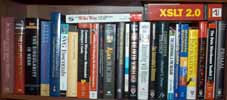Books on Software Development
Design Patterns
Erich
Gamma,
Richard
Helm,
Ralph
Johnson and
John Vlissides. Also known as the "Gang of Four" or simply "GoF"
Addison-Wesley Professional; 1st edition published January 15, 1995
If there is one book that differentiates programmers from software
architects it is this book. When it was published 1995 this book was a
landmark book. Its breakthrough was applying pattern principals developed
by Christopher Alexander in his book The Timeless Way of Building (see review
below). If there is any book that should be consider a classic in
software, this one would be it.
The Timeless Way of Building
Christopher Alexander
Oxford University Press, 1997
This is the original book by Christopher Alexander that started the pattern
movement. It is actually a very insightful book and the world "timeless"
should be taken very seriously. Ideally you would like to fill your brain
with information that does not become out-of-date with the next release of
Microsoft Windows. Object and design are indeed technologies that will be
with of for a long time. Here is one of my favorites quotes from the book:
We have a glimpse, then, of the fact that our world has structure, in the
simple fact that certain patters of events - both human and nonhuman - keep
repeating, and account, essentially, for much the greater parts of the events
with happen there.
Succeeding With Objects: Decision Frameworks for Project Management
Adele Goldberg, Kenneth S. Rubin
Addison-Wesley Professional; May 1995
Although this book is now around 10 years old, it still has excellent coverage of the social aspects of information sharing. Although the subject of
the book is the sharing of reusable Object-oriented frameworks, the material is
appropriate for many shared metadata and semantic web activities related to
metadata publishing and semantic brokers. I highly recommend this book to
non-programmers such as business analyst's, project managers and executives
interested in motivating groups to share any metadata.
XSLT 2.0 Programmer's Reference 3rd Edition
XPath 2.0 Programmer's Reference 3rd Edition
Michael Kay
There are few books in my collection that are as dog-eared as these books
(meaning they REALLY get a lot of use). Michael Kay is the author of the
very popular SAXON libraries for performing XML transformations. He is
also a key player in the XSLT standards committees at the W3C. He is a
brilliant developer and these books are the ultimate authority on XSL. If
you are building an enterprise metadata registry today you should also be
storing XML transforms of how to convert foreign data sets into these
standardized formats and how to export these structures. The best way to
store these in a vendor and OS neutral format is to use XSL. Make sure you
don't get forced into the older XSLT 1.0 standards. They are now very
out-of-date. And upgrading to 2.0 is usually just a matter of downloading
the SAXON libraries can calling them. Microsoft has not been able to
support 2.0 in their tools but you can always call SAXON from Apache Ant
scripts.
| 






